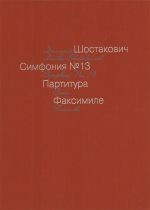| | Dmitri Shostakovich Simfonija no. 13. Partitura. Faksimile Symphony No. 13. Score. Facsimile. Facsimile edition of the autograph full score issued on the occasion of the 100th anniversary of the composer’s birth. Commentary by Manashir Jakubov. "DSCH" Publishers: Moscow, 2006. 30 x 41 cm, 196 pp. $350 |
| |  |
first page of score
(detail)
| | A poem by
Yevgeny Yevtushenko, a young, but
already very well-known poet at that
time, called “Babi Yar”, served as the
stimulus for beginning work on
the symphony. Babi Yar is a ravine on the northwest outskirts of Kiev,
where, carrying out Hitler’s plans to execute the “final solution”, the
German troops who occupied Ukraine shot approximately 100,000 Jews in
1941-1943. Although the composer finished a one-part composition using Yevtushenko's words in the Spring of 1962—Symphonic Poem "Babi Yar" for Bass, Bass Choir & Orchestra op.113—he almost immediately, and uncharacteristically, considered expanding the work. In a letter written to I.D. Glikmann he writes: “I am in some quandary... I don’t know who will be able to sing it. ...But in the meantime, I came up with the idea of writing something else along the same lines to Yevtushenko’s words. His little volume of poetry is making me think about writing a symphony in which “Babi Yar” will be the first or second movement... I hope Yevtushenko will now write me the poem I asked for. This is how the 13th Symphony is taking shape”. The composition went quickly, and the composer, partly writing from his hospital room, became carried away with working on the symphony, which provided an outlet for deep-seated ideas and emotions demanding embodiment. "New fears I see a-brightening: I fear insincerity to my land, debassing ideas with untruth is frightening, which for truth do utimately stand, I fear fanfaronading myself hoarse, I fear repeating others' words..." |
| Later
the composer writes: "I
have already
written the second and third movements of the 13th Symphony. The secord
movement: 'Humour' and the third movement: 'In the shop'... I do not
count on the full recognition of this composition, but I just could not
stop myself from writing it.". The
work experienced unexpected twists and turns during its emergence and
development of its central idea, and by dramatic upheavals in the fate
of the
finished work. After its premiere, the performance of this symphony,
was long banned, the poet was vehemently attacked in the press,
and it was never published in the author's homeland in its original and
unadulterated form. This high-quality reproduction makes this
masterpiece accessible for the first time in its authentic form and
gives us a glimpse into the composer’s creative process. The
introductory article by Manashir Jakubov (Rus-Eng) gives the first
detailed account of the composition and premiere of this symphony.
Cloth.
| |
Distributed by:
OMI - Old
Manuscripts & Incunabula PO Box 6019 FDR Station, New
York NY 10150
tel/fax 212/
758-1946 • http://www.omifacsimiles.com •
immels@earthlink.net

